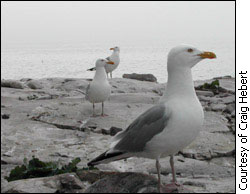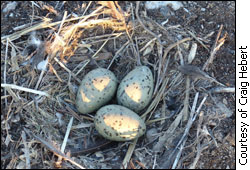
|
|
For over 30 years ecologists have been tracking the health of herring gulls to monitor the presence of pollution and other contaminants in the Great Lakes.
Craig Hebert, an ecologist for Environment Canada says that several years of research indicate that these birds may no longer be feeding on fish. It was this characteristic that originally made them ideal for determining the health of aquatic ecosystems. “Fish eating birds have been sort of a recurrent theme because they have high exposure to contaminants,” says Hebert. Looking at isotopes To find out what gulls feed on, he uses a method called stable isotope analysis to track changes in the birds’ position in the food web. He relies on isotopes of common elements that can be linked to different dietary characteristics. Nitrogen isotopes in animal tissue are good at indicating an animal's level in the food web. Studying carbon can locate where it has been feeding. Hebert has access to samples of eggs that have been collected annually from 15 gull colonies around the lakes since 1974. This provides an opportunity to track changes in their diets over a period of time. When he analyzed nitrogen in the eggs, he found that the herring gull’s position in the food web has fallen. “If the birds are now eating at a lower [level] than they used to in the past,” says Hebert “then we’re sort of not comparing the same exposure scenarios through time.” This can affect the results of contaminant monitoring when the data is compared to that of previous years.
Hebert analyzed the presence of carbon in the eggs to determine if the birds were still feeding on fish. The heavier carbon isotope, C-13 is more common in terrestrial food webs then it is in aquatic systems. If the herring gulls had been feeding on fish then their eggs would contain a much lower ratio of the heavy isotope than if they had been feeding on land. A new diet? Hebert’s analysis reveals that herring gulls have switched almost entirely to feeding on land.
When their food source declines, the gulls are forced to feed on land, where they hold a lower level in the food web. Here they eat anything from insects to small rodents and even human food and garbage. “The quality of that food in terms of the nutritional status of the birds is going to be affected,” says Hebert. “It’s like eating chips. You get the calories but you’re not going to be getting all the vitamins.” Future changes This explains the decline in population. It also raises questions about the future of the Herring Gull Monitoring Program. If the birds no longer feed on fish, then Hebert says any new data from the program will need to take that into consideration. The findings may no longer be an effective indicator of the health of the lakes. However, this does not signal an end to the program. “The impact of multiple stressors on these birds,” says Hebert, “is the thing that we really need to be concerned about.
Stable isotope analysis is opening up opportunities to use the herring gulls to monitor more than just the levels of contaminants in an ecosystem. Other factors such as food depletion, disease and even the presence of invasive species can be detected depending on which isotope is selected for analysis. The samples collected for the program are still priceless to scientists. “I think we don’t quite know what we may be using these samples for in the future but we would have never predicted in the 1970s that we’d be doing stable isotope analysis on them,” he says. Sean Kennedy, a toxicologist with the National Wildlife Centre says that a big concern today is newer chemicals such as bromated flame-retardants that are used to make materials less flammable in industry and every day life. “The bad side is that all of this gets thrown into garbage dumps and sunlight breaks them down.” Now scientists are finding large levels of these bromated flame-retardants in herring gull tissue. Due to Hebert’s work with stable isotope analysis, these trends can be linked to land contamination rather than to the Great Lakes. “We’ve found some of the greatest levels of bromated flame-retardants ever and they seem to be associated with terrestrial food webs,” says Hebert. Without the work in isotope analysis, it would have been difficult for scientists to make this link.
|
|
|


